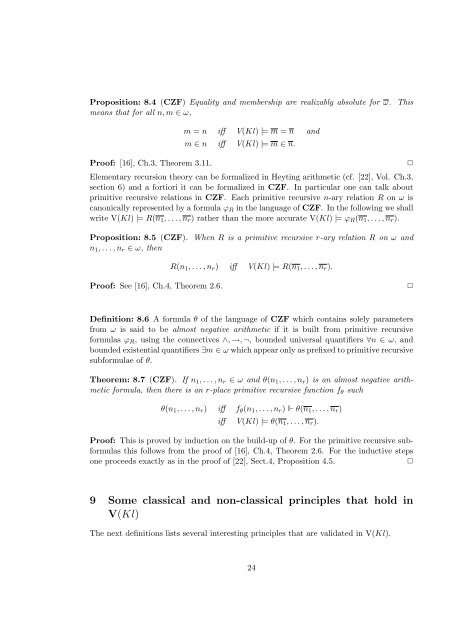Realizability for Constructive Zermelo-Fraenkel Set Theory
Realizability for Constructive Zermelo-Fraenkel Set Theory
Realizability for Constructive Zermelo-Fraenkel Set Theory
Create successful ePaper yourself
Turn your PDF publications into a flip-book with our unique Google optimized e-Paper software.
Proposition: 8.4 (CZF) Equality and membership are realizably absolute <strong>for</strong> ω. Thismeans that <strong>for</strong> all n, m ∈ ω,Proof: [16], Ch.3, Theorem 3.11.m = n iff V(Kl) |= m = n andm ∈ n iff V(Kl) |= m ∈ n.Elementary recursion theory can be <strong>for</strong>malized in Heyting arithmetic (cf. [22], Vol. Ch.3,section 6) and a <strong>for</strong>tiori it can be <strong>for</strong>malized in CZF. In particular one can talk aboutprimitive recursive relations in CZF. Each primitive recursive n-ary relation R on ω iscanonically represented by a <strong>for</strong>mula ϕ R in the language of CZF. In the following we shallwrite V(Kl) |= R(n 1 , . . . , n r ) rather than the more accurate V(Kl) |= ϕ R (n 1 , . . . , n r ).Proposition: 8.5 (CZF). When R is a primitive recursive r-ary relation R on ω andn 1 , . . . , n r ∈ ω, thenR(n 1 , . . . , n r ) iff V(Kl) |= R(n 1 , . . . , n r ).✷Proof: See [16], Ch.4, Theorem 2.6.✷Definition: 8.6 A <strong>for</strong>mula θ of the language of CZF which contains solely parametersfrom ω is said to be almost negative arithmetic if it is built from primitive recursive<strong>for</strong>mulas ϕ R , using the connectives ∧, →, ¬, bounded universal quantifiers ∀n ∈ ω, andbounded existential quantifiers ∃m ∈ ω which appear only as prefixed to primitive recursivesub<strong>for</strong>mulae of θ.Theorem: 8.7 (CZF). If n 1 , . . . , n r ∈ ω and θ(n 1 , . . . , n r ) is an almost negative arithmetic<strong>for</strong>mula, then there is an r-place primitive recursive function f θ suchθ(n 1 , . . . , n r ) iff f θ (n 1 , . . . , n r ) ⊩ θ(n 1 , . . . , n r )iff V(Kl) |= θ(n 1 , . . . , n r ).Proof: This is proved by induction on the build-up of θ. For the primitive recursive sub<strong>for</strong>mulasthis follows from the proof of [16], Ch.4, Theorem 2.6. For the inductive stepsone proceeds exactly as in the proof of [22], Sect.4, Proposition 4.5.✷9 Some classical and non-classical principles that hold inV(Kl)The next definitions lists several interesting principles that are validated in V(Kl).24
















